
Simply Speaking: The changing face of Big Tech brands - from focused value creators to conglomerates
Being a 'conglomerate' is again the name of the game. The sprawling new tech conglomerates in a hydra-headed structure will bring up fundamentals pertaining to the brand for a fresh application or re-evaluation
 L-R Jeff Bezos of Amazon, Elon Musk of Tesla, and Mark Zuckerberg of Meta. Image: Elon Musk and Mark Zuckerberg - Shutterstock. Jeff Bezos - Shannon Stapleton / Reuters
L-R Jeff Bezos of Amazon, Elon Musk of Tesla, and Mark Zuckerberg of Meta. Image: Elon Musk and Mark Zuckerberg - Shutterstock. Jeff Bezos - Shannon Stapleton / Reuters
One of the constantly in and out of fashion constructs in brand marketing is the concept of the conglomerate. In the last 50 years they have been on a see-saw where brand esteem is concerned. Storied names such as GE, ITT, Hanson Trust of Britain, the Japanese Zaibatsu and Korean Chaebols got feted as the highest branded manifestations of capitalism. Then they were rubbished as inefficient, defocused, bloated relics. Gold framed MBAs at Wall Street claimed that companies should focus relentlessly. They opined that it was investor dharma to minimise risk by choosing sector specific companies rather than backing corporate pachyderms. It came to pass that ‘diversification’ itself was reason enough to attract a “conglomerate discount”. Brands were seen as stretching irrationally when crossing sectoral boundary lines.
Warren Buffett – the sage of Omaha – must get credit for steadily resurrecting the stature of conglomerates. His investment vehicle, Berkshire Hathaway is a textbook conglomerate. When he bought Precision Castparts, a maker of aerospace components, for $37 billion, it was the biggest deal in Berkshire’s 50-year history. His method is focused on chasing growth and value over the longer term, and this knows no boundaries of vertical, category or industry.
It seems that the pendulum of guru opinion is shifting back again to the other extreme and ‘being a conglomerate’ is again the name of the game. What is surprising is that the leaders of the current pack are the pioneering and focused digital Tech leaders of the world - Google, Microsoft, Apple and Amazon. Google’s evolution as Alphabet goes well beyond its mammoth original, core business - internet search and advertising. It has birthed several subsidiaries from commercialising driverless cars to extending human lifespans, each a potential standalone company within the group. In effect, it is on course to become an increasingly diversified company.
This kind of metamorphosis is facilitated by two enablers - technology and secure cash flow. Information technology is transforming established industries, from mobility to education to manufacturing. Google - with the collective brain power its talent pool possesses and the cash pile its business generates - is well placed to pursue all sorts of projects, even as unrelated as creating artificial meat.
Also read: Simply Speaking: A brand mosaic and the little things that make it







